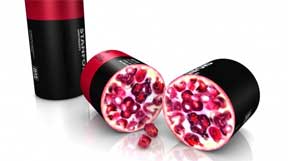|
| |
Pomegranate-inspired electrode creates longer lithium-ion battery
Main
Article page |
Beauty articles
|
Health page |
Computers|
Diseases |
Education |
Entertainment |
Family
Business |Fitness|
Fruits and Vegetables
|
Jobs |
General |
Personality|
Technology
|
Tourism |
Useful Tips
Biography Page|
Heroes & Incredible peoples
|
Inventions
Computer Main page |
Printer drivers|
Antivirus |
Children safety |
SMS|
Articles

By
Nick Lavars
: Though the use of silicon in lithium-ion batteries promises a whole new
world of energy storage, it also poses several problems to a battery's
durability and overall performance. A new electrode design inspired by
clusters of pomegranate seeds and developed by researchers at the Department
of Energy's National Accelerator Laboratory (SLAC) and Stanford University,
overcomes some of these obstacles, bringing lighter and more powerful
batteries closer to reality.
An anode (the part of the battery that stores
energy while the battery is charging) made from silicon is able to store ten
times the charge of graphite anodes used in today's lithium-ion batteries. This
holds significant possibilities for extending the battery life of common gadgets
such as cell phones, tablets and mobile phones, but there are various hurdles
that must first be overcome.
The fragile nature of the silicon compared to
graphite causes it to swell and eventually break while the battery is charging.
It also reacts nastily to the electrolyte of the battery, causing a gunk to form
on its coat and compromise the battery's performance. Previously, researchers
have overcome these problems by using silicon nanoparticles, which are already
too small break, and placing them in protective casings or "yolk shells" made
from carbon, with enough spare room inside for them to swell and shrink without
causing damage.
Read the full article from Gizmag
Articles:
|
|
-
Teen creates banana peels
into plastic
-
Science & technology: Questions and answers
-
Revolutionary technology produces 'petrol from air'
-
E-cigarettes are equally
injurious to health
-
A plane that can travel in water, sky or snow
-
Google tests
'real-time information' glasses
-
Science:
Botany,
Chemistry ,
Maths ,
Physics
-
Scientists Discover 12 New
Frog Species in India
-
What is Digital Cinema?
-
X-Ray microscope that
enables nanovision developed
-
Charge your mobile phone using boiling water
-
Google Music Beta
-
A robot to wash and dry
your hair!
-
Hot tips for buying a camera
-
Climate change
could destroy 80 per cent of rainforest
-
Transforming waste plastic
into an alternative fuel
-
Robot designed for safe
rescue operations post-disasters
-
Now a car with inbuilt
electric scooter
-
Flying cars may soon be a reality
-
Now, read txt msgs on
your watch
-
Aliens exist, but don't talk
to them, says Stephen Hawking
-
How insects decide what to
eat and what to avoid
-
Wireless nano sensors may save bridges, buildings
-
World's first vehicle 'green'
tires
-
Smokers aid spread of TB, say experts
-
How global warming can increase violence in human beings
-
Secret world of
honeybees' heat revealed
-
Now, mobile phones to
offer X-ray vision
-
Radar to monitor
vehicular movement
-
'Video games hurt schoolwork'
-
A guide to happiness, no matter how
bad things are
-
Breakthrough could make electronic devices smaller and cars energy
efficient
-
Darkness encourages cheating
-
Pigeons outdo humans at solving
'Monty Hall' problem
-
Steer by
wire -a car that doesn't require you to turn the steering wheel
-
Professor
turns chicken feathers into fuel
|
| |
|



